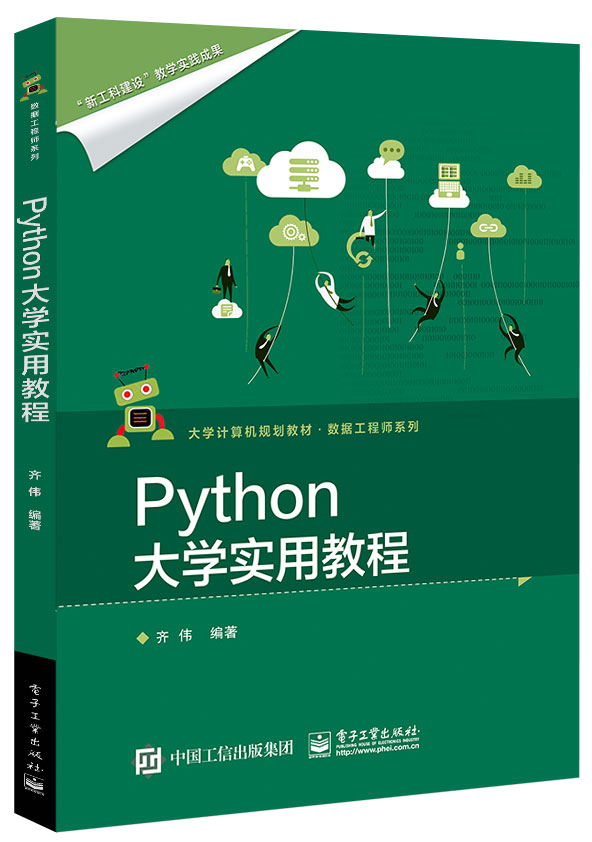与本文相关图书:《Python大学实用教程》

在前面的一篇文章《Python中的5对必知的魔法方法》中所介绍的“魔法方法”,或者说是特殊方法,其命名均是双下划线开始和结束。英文中称为“dunder methods”。为了更充分理解这类方法,本文通过一个示例,专门介绍此类方法的特点。
构建四元数对象
四元数是一个代数概念,通常用于描述旋转,特别是在3D建模和游戏中有广泛的应用。
$$Q = w + x\hat i + y\hat j + z\hat k$$
其中 $w,x, y, z \in \mathbb R,\hat i^2 + \hat j^2 +\hat k^2 = -1$ 。
下面就一步一步演示此对象的创建方法,特别要关注双下划线开始和结束的那些特殊方法。
1
2
3
4
5
6
| class Quaternion:
def __init__(self, w, x, y, z):
self.w = w
self.x = x
self.y = y
self.z = z
|
这是首先定义了__init__初始化方法,通过这个方法,在创建实例时将 $w,x,y,x$ 分别定义为实数。
1
2
3
| >>> q1 = Quaternion(1, 2, 3, 4)
>>> q1
<__main__.Quaternion at 0x7f4210f483c8>
|
貌似一个四元数对象定义了。但是,它没有友好的输出。接下来可以通过定义__repr__和__str__,让它对机器或者开发者都更友好。继续在类中增加如下方法:
1
2
3
4
5
6
7
8
9
10
11
12
13
14
| class Quaternion:
def __init__(self, w, x, y, z):
self.w = w
self.x = x
self.y = y
self.z = z
def __repr__(self):
return "Quaternion({}, {}, {}, {})".format(
self.w, self.x, self.y, self.z)
def __str__(self):
return "Q = {:.2f} + {:.2f}i + {:.2f}j + {:.2f}k".format(
self.w, self.x, self.y, self.z)
|
对于这两方法,在前面的《Python中的5对必知的魔法方法》中已经有介绍,请参考。
1
2
3
4
5
| >>> q1
Quaternion(1, 2, 3, 4)
>>> print(q1)
Q = 1.00 + 2.00i + 3.00j + 4.00k
|
实现代数运算
上述类已经能实现实例化了,但是,该对象还要参与计算,比如加、减法等。这类运算如何实现?
加法
1
2
3
4
5
6
7
8
9
10
11
12
13
14
15
16
17
18
19
20
21
| class Quaternion:
def __init__(self, w, x, y, z):
self.w = w
self.x = x
self.y = y
self.z = z
def __repr__(self):
return "Quaternion({}, {}, {}, {})".format(
self.w, self.x, self.y, self.z)
def __str__(self):
return "Q = {:.2f} + {:.2f}i + {:.2f}j + {:.2f}k".format(
self.w, self.x, self.y, self.z)
def __add__(self, other):
w = self.w + other.w
x = self.x + other.x
y = self.y + other.y
z = self.z + other.z
return Quaternion(w, x, y, z)
|
__add__是用于实现对象的加法运算的特殊方法。这样就可以使用+运算符了:
1
2
3
4
| >>> q1 = Quaternion(1, 2, 3, 4)
>>> q2 = Quaternion(0, 1, 3, 5)
>>> q1 + q2
Quaternion(1, 3, 6, 9)
|
减法
类似地,通过__sub__实现减法运算,不过,这次用一行代码实现。
1
2
3
4
5
6
7
8
9
10
11
12
13
14
15
16
17
18
19
20
21
22
23
24
| class Quaternion:
def __init__(self, w, x, y, z):
self.w = w
self.x = x
self.y = y
self.z = z
def __repr__(self):
return "Quaternion({}, {}, {}, {})".format(
self.w, self.x, self.y, self.z)
def __str__(self):
return "Q = {:.2f} + {:.2f}i + {:.2f}j + {:.2f}k".format(
self.w, self.x, self.y, self.z)
def __add__(self, other):
w = self.w + other.w
x = self.x + other.x
y = self.y + other.y
z = self.z + other.z
return Quaternion(w, x, y, z)
def __sub__(self, other):
return Quaternion(*list(map(lambda i, j: i - j, self.__dict__.values(), other.__dict__.values())))
|
有点酷。这里使用了实例对象的__dict__属性,它以字典形式包含了实例的所有属性,请参考《Python大学实用教程》中的详细讲解。
乘法
乘法,如果了解一下线性代数,会感觉有点复杂。其中常见的一个是“点积”,自从Python3.5以后,用@符号调用__matmul__方法实现,对于四元数对象尔雅不能,就是元素与元素对应相乘。
对于四元数而言——本质就是向量,也可以说是矩阵,其乘法就跟矩阵乘法类似,比如,同样不遵守互换率:$Q_1Q_2 \ne Q_2Q_1$ 。
1
2
3
4
5
6
7
8
9
10
11
12
13
14
15
16
17
18
19
20
21
22
23
24
25
26
27
28
29
30
31
32
33
34
35
36
| class Quaternion:
def __init__(self, w, x, y, z):
self.w = w
self.x = x
self.y = y
self.z = z
def __repr__(self):
return "Quaternion({}, {}, {}, {})".format(
self.w, self.x, self.y, self.z)
def __str__(self):
return "Q = {:.2f} + {:.2f}i + {:.2f}j + {:.2f}k".format(
self.w, self.x, self.y, self.z)
def __add__(self, other):
w = self.w + other.w
x = self.x + other.x
y = self.y + other.y
z = self.z + other.z
return Quaternion(w, x, y, z)
def __sub__(self, other):
return Quaternion(*list(map(lambda i, j: i - j, self.__dict__.values(), other.__dict__.values())))
def __mul__(self, other):
if isinstance(other, Quaternion):
w = self.w * other.w - self.x * other.x - self.y * other.y - self.z * other.z
x = self.w * other.x + self.x * other.w + self.y * other.z - self.z * other.y
y = self.w * other.y + self.y * other.w + self.z * other.x - self.x * other.z
z = self.w * other.z + self.z * other.w + self.x * other.y - self.y * other.x
return Quaternion(w, x, y, z)
elif isinstance(other, (int, float)):
return Quaternion(*[other * i for i in self.__dict__.values()])
else:
raise TypeError("Operation undefined.")
|
在__mul__方法中,如果other引用一个四元数对象,那么就会计算Hamilton积,并返回一个新的对象;如果other是一个标量(比如整数),就会与四元数对象中的每个元素相乘。
如前所述,四元数的乘法不遵循交换律,但是,如果执行2 * q1这样的操作,按照上面的方式,会报错——在上面的__mul__方法中解决了q1 * 2的运算,而一般我们认为这两个计算是相同的。为此,定义了·rmul·来解决此问题:
1
2
3
4
5
6
7
8
9
10
11
12
13
14
15
16
17
18
19
20
21
22
23
24
25
26
27
28
29
30
31
32
33
34
35
36
37
38
39
40
41
42
| class Quaternion:
def __init__(self, w, x, y, z):
self.w = w
self.x = x
self.y = y
self.z = z
def __repr__(self):
return "Quaternion({}, {}, {}, {})".format(
self.w, self.x, self.y, self.z)
def __str__(self):
return "Q = {:.2f} + {:.2f}i + {:.2f}j + {:.2f}k".format(
self.w, self.x, self.y, self.z)
def __add__(self, other):
w = self.w + other.w
x = self.x + other.x
y = self.y + other.y
z = self.z + other.z
return Quaternion(w, x, y, z)
def __sub__(self, other):
return Quaternion(*list(map(lambda i, j: i - j, self.__dict__.values(), other.__dict__.values())))
def __mul__(self, other):
if isinstance(other, Quaternion):
w = self.w * other.w - self.x * other.x - self.y * other.y - self.z * other.z
x = self.w * other.x + self.x * other.w + self.y * other.z - self.z * other.y
y = self.w * other.y + self.y * other.w + self.z * other.x - self.x * other.z
z = self.w * other.z + self.z * other.w + self.x * other.y - self.y * other.x
return Quaternion(w, x, y, z)
elif isinstance(other, (int, float)):
return Quaternion(*[other * i for i in self.__dict__.values()])
else:
raise TypeError("Operation undefined.")
def __rmul__(self, other):
if isinstance(other, (int, float)):
return self.__mul__(other)
else:
raise TypeError("Operation undefined.")
|
相等
比较两个四元数是否相等,可以通过定义__eq__方法来实现。
1
2
3
4
5
6
7
8
9
10
11
12
13
14
15
16
17
18
19
20
21
22
23
24
25
26
27
28
29
30
31
32
33
34
35
36
37
38
39
40
41
42
43
44
45
46
| class Quaternion:
def __init__(self, w, x, y, z):
self.w = w
self.x = x
self.y = y
self.z = z
def __repr__(self):
return "Quaternion({}, {}, {}, {})".format(
self.w, self.x, self.y, self.z)
def __str__(self):
return "Q = {:.2f} + {:.2f}i + {:.2f}j + {:.2f}k".format(
self.w, self.x, self.y, self.z)
def __add__(self, other):
w = self.w + other.w
x = self.x + other.x
y = self.y + other.y
z = self.z + other.z
return Quaternion(w, x, y, z)
def __sub__(self, other):
return Quaternion(*list(map(lambda i, j: i - j, self.__dict__.values(), other.__dict__.values())))
def __mul__(self, other):
if isinstance(other, Quaternion):
w = self.w * other.w - self.x * other.x - self.y * other.y - self.z * other.z
x = self.w * other.x + self.x * other.w + self.y * other.z - self.z * other.y
y = self.w * other.y + self.y * other.w + self.z * other.x - self.x * other.z
z = self.w * other.z + self.z * other.w + self.x * other.y - self.y * other.x
return Quaternion(w, x, y, z)
elif isinstance(other, (int, float)):
return Quaternion(*[other * i for i in self.__dict__.values()])
else:
raise TypeError("Operation undefined.")
def __rmul__(self, other):
if isinstance(other, (int, float)):
return self.__mul__(other)
else:
raise TypeError("Operation undefined.")
def __eq__(self, other):
r = list(map(lambda i, j: abs(i) == abs(j), self.__dict__.values(), other.__dict__.values()))
return sum(r) == len(r)
|
其他运算
下面的方法,也可以接续到前面的类中,不过就不是特殊放方法了。
1
2
3
4
5
6
7
8
9
10
11
12
13
14
15
16
17
18
| from math import sqrt
def norm(self):
return sqrt(sum([i**2 for i in self.__dict__.values()))
def conjugate(self):
x, y, z = -self.x, -self.y, -self.z
return Quaterion(self.w, x, y, z)
def normalize(self):
norm = self.norm()
return Quaternion(*[i / norm for in self.__dict__.values()])
def inverse(self):
qconj = self.conjugate()
norm = self.norm()
return Quaternion(*[i / norm for i in qconj.__dict__.values()])
|
用这些方法实现了各自常见的操作。
通过本文的这个示例,可以更深刻理解双下划线的方法为编程带来的便捷。


